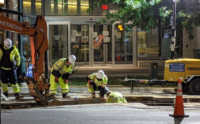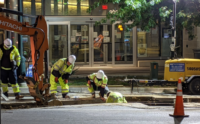Full-scale construction on Maryland’s Purple Line light-rail system appears set to resume after Labor Day, with the long delayed project's new design-build joint venture inking a project labor agreement with one of metropolitan Washington, D.C.’s largest craft unions.
The Dragados-OHL-led team, selected last year by the project's private management consortium to take over the project after its previous Fluor-led JV departed in 2020, completed negotiations with Laborers’ International Union of North America (LIUNA) Local 11 in late August on an agreement that will cover the remaining four years of construction.
“This works for everyone,” says Local 11 business manager Steve Lanning, adding that the Dragados-OHL team, called Maryland Transit Solutions, "will be assured of having quality craft labor for a major, long-term project, and be able to budget accordingly.”
Local 11, which had a labor agreement with the previous construction team, will be the largest craft union involved on the project, with more than 200 members expected to be on site, he says.
Completion of a tunnel for the underground western terminus station in Bethesda will be among the restart’s priorities, he says, along with above-ground excavation and foundation work at multiple locations on the 16.2-mile transit line across densely populated Washington suburbs in two counties.
“The rail work, when it gets started, will be huge for us,” Lanning adds.
Private consortium Purple Line Transit Partners LLC—which has a 40-year concession to design, build, operate and maintain the light rail line—said In a statement it is “pleased to come to terms with LIUNA on an agreement guaranteeing their ability to provide high-quality laborers. At a time of workforce shortages across almost every economic sector, the labor agreement will ensure we're able to start boarding passengers in fall 2026."
Heralded as a milestone in public-private infrastructure projects when work began in mid-2017, the Purple Line was eventually beset by schedule delays, nearly $1 billion in cost overruns and spiraling acrimony between Fluor and state transportation officials. The contractor unilaterally quit the half-finished project in September 2020, and as part of its settlement with the state, received $250 million and surrendered its interest in the consortium.
Since Fluor’s departure, the Maryland Transit Administration has overseen a scaled-back construction effort along the Purple Line route that has focused largely on utility relocations.
The Dragados-OHL team was tapped by the consortium to take over the project in November 2021 under a $3.4-billion contract, announced earlier this year, which is 75% higher than when Fluor began work.
While provisions for rising materials costs have not been disclosed, the contract calls for the Purple Line to begin revenue service in late 2026—more than four years behind the original schedule—with a daily penalty of more than $200,000 for missing the target completion date. The contract also includes a revised dispute resolution process that consortium and Maryland officials say will help prevent problems that contributed to the deteriorated relationship with Fluor.
In April, contractor officials said they would need up to four months to perform surveys and other due diligence assessments of trackwork, foundations, tunnel connections with existing Metrorail stations and other partially completed elements. A completed operations and maintenance facility for the Purple Line was turned over to the new construction team in June.
Since mid-August, crews have begun reactivating several jobsites to install drainage and erosion control systems, erect retaining walls and complete utility relocations, according to information on the project website. Work has also begun on the foundation for a traction power substation and completion of the partially complete light rail and adjacent pedestrian trail bridges in Rock Creek Park.






Post a comment to this article
Report Abusive Comment